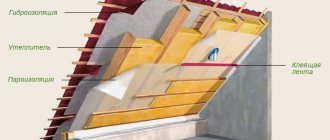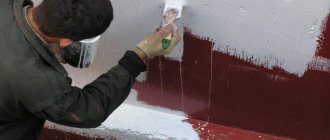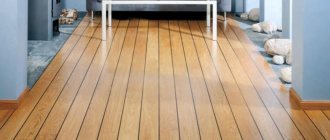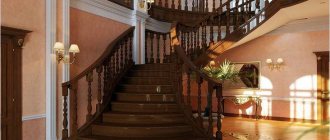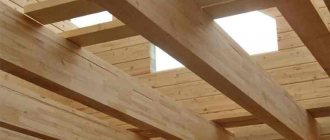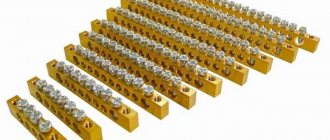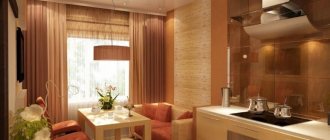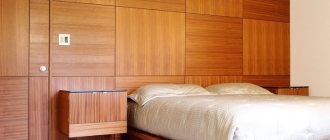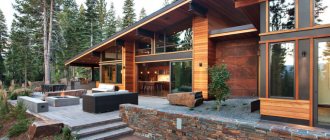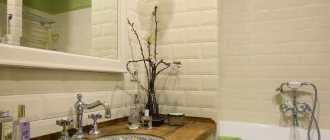Home / Installation, repair, maintenance / Insulation / Using penoplex to insulate walls from the inside
Sometimes it is simply not possible to install a heat-saving structure on the outside of the house. In such a situation, you have to work indoors and many people choose a simple and inexpensive material for such work - penoplex. Insulating walls from the inside with penoplex is not difficult and you can easily do it yourself.
What is it and where is penoplex used?
Penoplex (“Penoplex”) is a large company that produces construction and finishing materials. The company also produces extruded (melted in a high-pressure oven) expanded polystyrene (EPS, XRS) or penoplex. This is a thermal insulation material that has excellent thermal characteristics. A sheet of material just 2 cm thick retains as much heat as a 20 cm thick wooden wall, 27 cm thick foam concrete or 37 cm thick brick wall.
Compared to foamed polystyrene (foam), penoplex has a higher density, so it better withstands mechanical loads. The material has low moisture permeability and almost does not conduct steam.
Penoplex is used when resistance to stress and low vapor permeability are important. It is used:
- For insulation of floors, facades, internal walls, non-residential basements;
- On flat roofs;
- For insulation of wells and septic tanks;
- On paths and playgrounds.
Using penoplex Source prom.st
The company produces several brands of material that differ in properties. For example, for insulation of foundations and underground garages, frost-resistant “Penoplex Comfort” or “Foundation” is used (it can withstand heavy loads), for insulation of balconies and external walls - “Wall” with low thermal conductivity, for roofs - non-flammable “Roof”.
At the same time, it is important to establish a ventilation system, which, like penoplex, does not allow steam to pass through. In the home, this can lead to increased humidity and the need for artificial regulation. However, this is not always necessary: for example, when insulating the floor, ventilation is not needed.
See also: Catalog of companies that specialize in finishing materials and related work
Famous manufacturers
The main well-known brands for plastering polystyrene foam are produced by the following companies:
- the Sto AG concern (Germany) offers a line of Stolit plaster mixtures;
- Henkel concern (Germany) produces Ceresit plaster mixtures;
- Ecomix company produces mixtures of the same name for Wet facades.
Line of materials from the Russian subsidiary of the German concern Sto AG:
- Sto-Baukleber (for gluing polystyrene foam);
- StolevellDuoplus or Uni (for gluing and reinforcement);
- StoPutzgrund or StoPrep Miral (intermediate priming);
- Sto-Strukturputz or StoMarlit (finishing plaster mixtures).
Ecomix offers:
- adhesive for mounting polystyrene foam – BS-113;
- plaster and adhesive composition for making a reinforced layer on top of slabs - BS-106;
- quartz primer – BS-707;
- for finishing – decorative mixture “bark beetle” BS 208 or pebble BS
The German company Knauf offers the “Warm Wall” line, including the following compositions:
- Sevener (plaster and adhesive);
- Decorgrund (primer);
- Diamond (decorative).
Advantages and disadvantages
It is worth finding out whether penoplex is harmful to health. Like any material, it has a number of pros and cons. To understand whether it is harmful to health, it is worth learning a little more about insulation.
The advantages of the material include:
- Long service life: penoplex can be used for up to 50 years;
- Tolerates low (up to -50 degrees) and high (up to +75 degrees) temperatures;
- Does not absorb water, does not require additional waterproofing;
Penoplex close up Source sladkiyson.net
- Does not react with most chemicals. The material is destroyed only upon contact with a solvent;
- Withstands mechanical loads without breaking. On average, penoplex can withstand pressure of up to 4 kg per square centimeter, some brands (for example, “Foundation”) - up to 27 kg. Polystyrene foam can withstand no more than 0.5 kg per square centimeter.
In addition, the material is easy to use. It does not require additional processing or special skills; it can be cut with a knife and glued with glue or special foam.
Penoplex has some disadvantages:
- It is easily destroyed when exposed to direct sunlight. When working with it, it is better to choose a cloudy day and do everything quickly;
- It is easy for mice to breed in it;
- Its cost is higher than that of other insulation materials;
- Penoplex is flammable. It belongs to categories G3 and G4, which include the most flammable materials.
In advertising they often say that the material does not burn and is safer than wood. This is not so: you can determine whether penoplex is harmful by its flammability. The material is highly flammable and emits vapors that are hazardous to health. You can reduce the harm by treating the sheets with fire retardant compounds. This will help reduce flammability to class G1. In the event of a fire, the penoplex will melt and will not be able to support the fire.
Technology of work execution
Experts recommend performing actions in the following order:
- Surface preparation. At this stage, it is necessary to remove the old decorative covering (wallpaper or other facing materials) from the wall. After removal, the surface is cleaned of dust and dirt and checked for unevenness. If depressions or cracks are found, they must be sealed with putty. Surfaces on which condensation has formed over time are often affected by fungus or mold. To eliminate the problem, the walls are treated with special antiseptic compounds. Next, a primer is applied to the wall. After it dries, you can proceed to the next stage.
- A special waterproofing film is attached to the wall. Penoplex does not absorb moisture, so this step can be skipped. This is an optional condition, but it is better to be safe.
- The slabs are cut to the required sizes. For this you will need: a ruler, a square, a knife.
- Prepare an adhesive solution, which is selected in accordance with the recommendations of the heat insulator manufacturer. Mix according to the instructions on the package.
Applying glue to the slab - The glue is applied to the slabs and to the wall. It is first recommended to attach the thermal insulation elements to the wall to check the geometry, after which they are glued.
- Next, additional fastening is provided with plastic dowels. This step can be skipped, but it will provide greater reliability.
- Check the tightness of the connection in the areas of window and door openings. Fill the seams between the slabs with sealant. If problem areas with large distances are found, you can use polyurethane foam for filling.
- Vapor barrier. Just like waterproofing, it is not necessary for penoplex, but it will help avoid unexpected troubles.
After this, the interior decoration of the premises begins. There are several options here. You can apply plaster over the penoplex layer. Drywall is used as a more reliable protection. For wall fencing, a thickness of 12.5 mm in one layer will be sufficient. Next, the drywall can be plastered or wallpapered.
The method of insulation from the room side is somewhat similar to the wet facade technology. Proper thermal insulation with penoplex will provide comfortable living conditions and reduce heat losses of the building.
Requirements for insulation
Insulation is an important material in construction that can affect the health and safety of occupants. You shouldn't choose based on price alone.
When choosing insulation, it is important to pay attention to the following points:
- The material should not contain fine fibers or dust;
- It should not contain harmful phenol-formaldehyde resins;
- During operation, it does not emit harmful substances even at high temperatures;
- It practically does not get wet, since fungi and mold easily grow in wet material.
According to these criteria, penoplex is absolutely safe. It has the necessary certificates of conformity, has passed all tests and is found safe when used correctly.
Balcony insulation Source remontnik.ru
Finishing
As soon as the reinforcing layer has dried, it must be rubbed with an abrasive float. Then two or three leveling layers of the adhesive mixture are applied, and each of them is dried for 24 hours. The dry surface can be primed and plastered.
Finally. The result of covering walls with penoplex is noticeable immediately. The home becomes warm and dry, heating costs are reduced. If you additionally insulate the floor, roof and foundation with penoplex, the house will be truly energy efficient.
Myths about insulation
Reviews of penoplex are varied, and there are many questions about whether polystyrene foam is harmful as insulation indoors. Some believe that extruded polystyrene foam is harmful and should not be used in the home, others note that the material is completely safe.
The most popular myths include the following:
- Penoplex emits harmful fumes. This is not true: when processing sheets, the material becomes greatly compacted and generally stops releasing vapor into the air. In addition, the sheets are covered on the outside with a finish that will not let harmful substances through, even if they are present.
- The insulation does not allow steam to pass through, which is harmful for residents and the material itself. The walls should not allow moisture or steam to pass through, as the room will become damp. To prevent the insulation itself from getting wet, it is enough to provide good ventilation.
- The presence of penoplex increases the risk of fire. This is a controversial statement. The insulation itself will not catch fire, but during a fire it easily flares up and releases hazardous substances. The sheets must be additionally treated with fire retardant compounds so that they do not burn, but melt.
Preparing the walls
Before insulation, clean and level the walls.
Before you begin finishing the surface, it must be properly prepared.
Already in a habitable room, the walls are cleaned of old plaster.
But if it is in excellent condition, then the coating can be left.
The cleaned wall is leveled; if necessary, a mesh is used, and a leveling compound is applied on top of it.
Video description
You can learn about the fire hazard of penoplex from the video:
- There are a lot of negative reviews from those who are already using the material. There are few negative reviews; they are in no way directly related to harmful effects. There are much more positive reviews: buyers note that they were not disappointed in the penoplex and did not notice any shortcomings.
Thus, it is not difficult to decide whether polystyrene foam as indoor insulation is harmful to health.
It is important to remember that only products from well-known manufacturers are safe. It has passed the appropriate tests and can be used in residential buildings. It is also important to remember that the technical characteristics of penoplex are maintained only with proper installation and operation. Although there are very few situations in which these conditions can be violated.
Briefly about the main thing
Penoplex is a new material for insulation. Its main differences are strength, durability, resistance to various temperatures and exposure to water.
The main disadvantages of insulation are its high price, the likelihood of mice appearing inside it, and high flammability. Penoplex belongs to the flammability groups G3 and G4.
Despite the large number of myths, penoplex is safe and does not harm humans in any way during operation. Only products from well-known manufacturers that have passed the necessary tests and received certificates are distinguished by high quality.
In case of fire, sheets can release harmful substances. To prevent this from happening, it is necessary to treat them with special solutions.
Ratings 0
Advantages and features of insulating a brick house from the outside with polystyrene foam for siding
- 1 Finishing with siding: the need to insulate the walls outside
- 2 Features of insulation of brick houses 2.1 Choice of material: advantages of expanded polystyrene 2.1.1 Disadvantages of expanded polystyrene
- 3.1 Stages of insulation
- 4.1 Related articles
Despite the natural attractiveness and durability of brickwork, building facades sooner or later require restoration and repair. Particularly relevant is the issue of wall finishing to improve the thermal insulation properties of structures, which helps to significantly reduce heating costs in the winter and increase the level of comfort in the summer. The best option is to insulate the outside walls of a brick house with polystyrene foam under the siding. This is a fairly economical and effective solution. It is most applicable specifically for cladding a brick building, but not for a wooden cottage, the thermal insulation of which is carried out with completely different materials.
